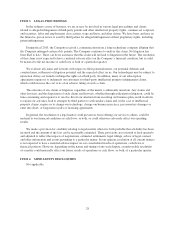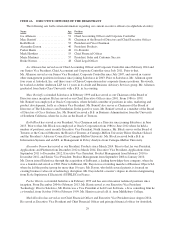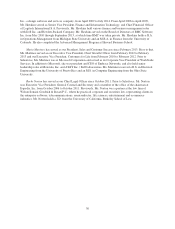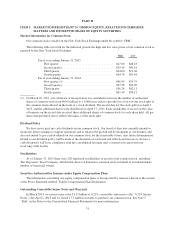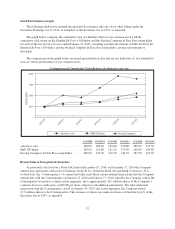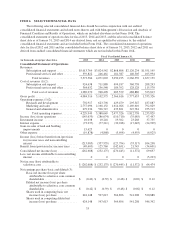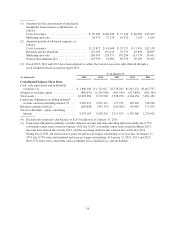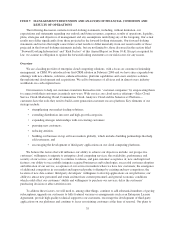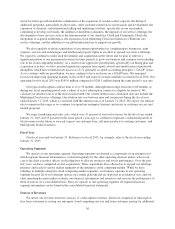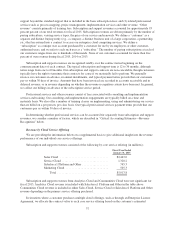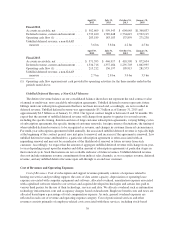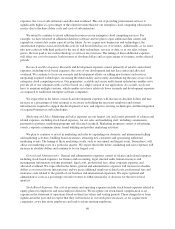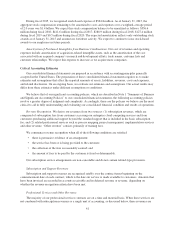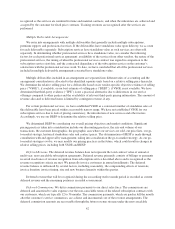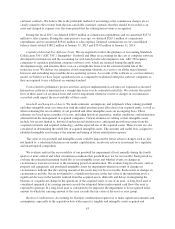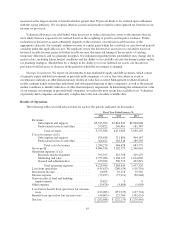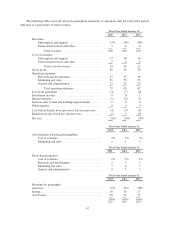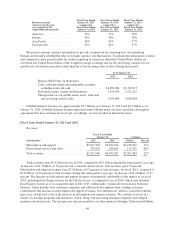Salesforce.com 2015 Annual Report Download - page 44
Download and view the complete annual report
Please find page 44 of the 2015 Salesforce.com annual report below. You can navigate through the pages in the report by either clicking on the pages listed below, or by using the keyword search tool below to find specific information within the annual report.
product demand plan and the service that was provided at the inception of the contract. We do not update these
allocations based on actual product usage during the term of the contract. We have allocated approximately 10
percent of our total subscription and support revenues for fiscal 2015, based on customers’ estimated product
demand plans and these allocated amounts are included in the table above.
Additionally, some of our core service offerings have similar features and functions. For example,
customers may use the Sales Cloud, the Service Cloud or our Salesforce1 Platform to record account and contact
information, which are similar features across these core service offerings. Depending on a customer’s actual and
projected business requirements, more than one core service offering may satisfy the customer’s current and
future needs. We record revenue based on the individual products ordered by a customer, and not according to
the customer’s business requirements and usage. In addition, as we introduce new features and functions within
each offering, and refine our allocation methodology for changes in our business, we do not expect it to be
practical to adjust historical revenue results by core service offering for comparability. Accordingly, comparisons
of revenue performance by core service offering over time may not be meaningful.
Our Sales Cloud service offering is our most widely distributed service offering and has historically been
the largest contributor of subscription and support revenues. As a result, Sales Cloud has the most international
exposure and foreign exchange rate exposure, relative to the other cloud service offerings. Conversely, revenue
for Marketing Cloud is primarily derived from the Americas, with little impact from foreign exchange rate
movement. We estimate that for fiscal 2016, subscription and support revenues from the Sales Cloud service
offering will continue to be the largest contributor of subscription and support revenue, and foreign currency will
continue to have a more pronounced impact on Sales Cloud subscription and support revenues than revenues
from our other cloud service offerings.
Seasonal Nature of Deferred Revenue, Accounts Receivable and Operating Cash Flow
Deferred revenue primarily consists of billings to customers for our subscription service. Over 90 percent of
the value of our billings to customers is for our subscription and support service. We generally invoice our
customers in annual cycles. Approximately 80 percent of all subscription and support invoices were issued with
annual terms during fiscal 2015 in comparison to nearly 74 percent during fiscal 2014. Occasionally, we bill
customers for their multi-year contract on a single invoice which results in an increase in noncurrent deferred
revenue. We typically issue renewal invoices in advance of the renewal service period, and depending on timing,
the initial invoice for the subscription and services contract and the subsequent renewal invoice may occur in
different quarters. This may result in an increase in deferred revenue and accounts receivable. There is a
disproportionate weighting towards annual billings in the fourth quarter, primarily as a result of large enterprise
account buying patterns. Our fourth quarter has historically been our strongest quarter for new business and
renewals. The year on year compounding effect of this seasonality in both billing patterns and overall new and
renewal business causes the value of invoices that we generate in the fourth quarter for both new business and
renewals to increase as a proportion of our total annual billings. Accordingly, because of this billing activity, our
first quarter is historically our largest collections and operating cash flow quarter.
The sequential quarterly changes in accounts receivable, related deferred revenue and operating cash flow
during the first three quarters of our fiscal year are not necessarily indicative of the billing activity that occurs in
the fourth quarter as displayed below (in thousands, except unbilled deferred revenue):
April 30,
2014
July 31,
2014
October 31,
2014
January 31,
2015
Fiscal 2015
Accounts receivable, net ................. $ 684,155 $ 834,323 $ 794,590 $1,905,506
Deferred revenue, current and noncurrent .... 2,324,615 2,352,904 2,223,977 3,321,449
Operating cash flow (1) .................. 473,087 245,893 122,511 332,223
Unbilled deferred revenue, a non-GAAP
measure ............................ 4.8bn 5.0bn 5.4bn 5.7bn
38


